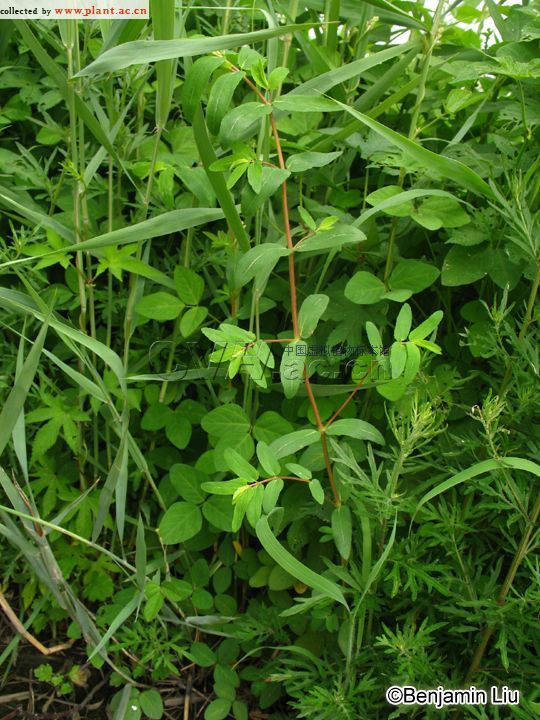通奶草Euphorbia hypericifolia Linn.
通奶草Euphorbia hypericifolia Linn.
6.通奶草(海南植物志)
Euphorbia hypericifolia Linn. Sp. Pl. 454. 1753; Boiss. in DC. Prodr. 15 (2): 23. 1862; Hook. f. Fl. Brit. Ind. 5: 249. 1887; Forb.& Hemsl. in Journ. Linn. Soc. Bot. 26: 415. 1891; Levl. in Bull. Herb. Boiss. 2, 6: 763. 1906; Dunn&Tutcher in Kew Bull. Misc. Inform., add. Set. 10: 232. 1912; T. N. Liou in Contrib. Lab. Bot. Nat. Acad. Peiping 1 (1): 5. 1931; Airy-Shaw in Kew Bull. 26 (2): 263, 1971; 云南种子植物名录1: 440. 1984; A. Radcliffe-Smith in Nasir & Ali, Fl. Pakist. 172; 98. fig. 17; E-G. 1986; J. S. Ma & C. Y. Wu in Acta Bot. Yunnan. 14 (4): 365. 1992; et in Collect. Bot. 21; 104. 1992; 横断山维管植物1: 1064, 1993. ——E. indica Lam. Encycl. Meth. Bot. 2: 423. 1788; Boiss. in DC. Prodr. 15 (2): 22. 1862; Gagnep. in Lecomte, Fl. Gen. Indo-Chine 5: 248. 1925; Merr. in Lingn. Sc. Journ. 5: 113. 1927; Hand. -Mazz: Symb. Sin., (2): 225. 1931; Chun in Sunyatsenia 2: 64. 1934; Prokh. in Kom. Fl. URSS 14: 486. 1949; 海南植物志2: 185. 1965; 中国高等植物图鉴2; 620.图2969.1972;湖北植物志2: 387.图1293.1979; 北京植物志1: 526. 1984; A. Radcliffe-Smith in Nasir & Ail, Fl. Pakist. 172: 76. fig. 17: H-J. 1986; 福建植物志3: 224.图154. 1987; 贵州植物志6: 139. 1989.
一年生草本,根纤细,长10-15厘米,直径2-3.5毫米,常不分枝,少数由末端分枝。茎直立,自基部分枝或不分枝,高15-30厘米,直径1-3毫米,无毛或被少许短柔毛。叶对生,狭长圆形或倒卵形,长1-2.5厘米,宽4-8毫米,先端钝或圆,基部圆形,通常偏斜,不对称,边缘全缘或基部以上具细锯齿,上面深绿色,下面淡绿色,有时略带紫红色,两面被稀疏的柔毛,或上面的毛早脱落;叶柄极短,长1一2毫米;托叶三角形,分离或合生。苞叶2枚,与茎生叶同形。花序数个簇生于叶腋或枝顶,每个花序基部具纤细的柄,柄长3-5毫米;总苞陀螺状,高与直径各约1毫米或稍大;边缘5裂,裂片卵状三角形;腺体4,边缘具白色或淡粉色附属物。雄花数枚,微伸出总苞外;雌花1枚,子房柄长于总苞;子房三棱状,无毛;花柱3,分离;柱头2浅裂。蒴果三棱状,长约1.5毫米,直径约2毫米,无毛,成熟时分裂为3个分果爿。种子卵棱状,长约1.2毫米,直径约0.8毫米,每个棱面具数个皱纹,无种阜。花果期8-12月。
产于长江以南的江西、台湾、湖南、广东、广西、海南、四川、贵州和云南;近年在我国北京发现逸为野生的现象。生于旷野荒地,路旁,灌丛及田间。广布于世界热带和亚热带。模式标本采自东印度。
全草入药,通奶,故名。
《Flora of China》 Vol. 11 (2008)
Euphorbia hypericifolia Linnaeus
通奶草 tong nai cao
Herbs, annual, 15-30 cm tall. Root fibrous, 2-3.5 mm thick. Stems branched mainly from upper parts, erect, 1-3 mm thick, glabrous or sparsely pilose. Leaves opposite; stipules triangular, 1.3-1.5 mm, free or connate; petiole 1-2 mm; leaf blade narrowly oblong or obovate, 1-2.5 cm × 4-8 mm, adaxially dark green, light green abaxially, sometimes purple-red, sparsely pilose on both surfaces, or glabrescent abaxially, base rounded, margin entire or finely serrulate toward apex, apex obtuse or rounded; involucral leaves 2, similar to normal leaves. Cyathia many in axillary or terminal cymes, peduncle 3-5 mm; involucre turbinate, ca. 1 × 1 mm, marginal lobes 5, ovate-triangular; glands 4, appendages white or light pink. Male flowers numerous, slightly exserted from involucre. Female flower: pedicel longer than involucre; ovary 3-angular, glabrous; styles free; stigma slightly 2-lobed. Capsule 3-angular, 1-1.5 × ca. 2 mm, smooth, glabrous. Seeds ovoid-angulate, ca. 1.2 × 0.8 mm, each side with several striae; caruncle absent. Fl. and fr. Aug-Dec. 2n = 32*.
Fields, roads, scrub. Beijing, Guangdong, Guangxi, Guizhou, Hainan, Hunan, Jiangxi, Sichuan, Taiwan, Yunnan [New World; naturalized in many parts of the Old World].
This species is used medicinally. It has been much confused with Euphorbia indica but that species differs by the puberulent stems and capsules (see Raju & Rao, Indian J. Bot. 2: 202. 1979).
别名:光叶飞扬;光叶小飞杨;夹白;奶通草;
科名:大戟科 Euphorbiaceae
属名:大戟属 Euphorbia

6.通奶草(海南植物志)
Euphorbia hypericifolia Linn. Sp. Pl. 454. 1753; Boiss. in DC. Prodr. 15 (2): 23. 1862; Hook. f. Fl. Brit. Ind. 5: 249. 1887; Forb.& Hemsl. in Journ. Linn. Soc. Bot. 26: 415. 1891; Levl. in Bull. Herb. Boiss. 2, 6: 763. 1906; Dunn&Tutcher in Kew Bull. Misc. Inform., add. Set. 10: 232. 1912; T. N. Liou in Contrib. Lab. Bot. Nat. Acad. Peiping 1 (1): 5. 1931; Airy-Shaw in Kew Bull. 26 (2): 263, 1971; 云南种子植物名录1: 440. 1984; A. Radcliffe-Smith in Nasir & Ali, Fl. Pakist. 172; 98. fig. 17; E-G. 1986; J. S. Ma & C. Y. Wu in Acta Bot. Yunnan. 14 (4): 365. 1992; et in Collect. Bot. 21; 104. 1992; 横断山维管植物1: 1064, 1993. ——E. indica Lam. Encycl. Meth. Bot. 2: 423. 1788; Boiss. in DC. Prodr. 15 (2): 22. 1862; Gagnep. in Lecomte, Fl. Gen. Indo-Chine 5: 248. 1925; Merr. in Lingn. Sc. Journ. 5: 113. 1927; Hand. -Mazz: Symb. Sin., (2): 225. 1931; Chun in Sunyatsenia 2: 64. 1934; Prokh. in Kom. Fl. URSS 14: 486. 1949; 海南植物志2: 185. 1965; 中国高等植物图鉴2; 620.图2969.1972;湖北植物志2: 387.图1293.1979; 北京植物志1: 526. 1984; A. Radcliffe-Smith in Nasir & Ail, Fl. Pakist. 172: 76. fig. 17: H-J. 1986; 福建植物志3: 224.图154. 1987; 贵州植物志6: 139. 1989.
一年生草本,根纤细,长10-15厘米,直径2-3.5毫米,常不分枝,少数由末端分枝。茎直立,自基部分枝或不分枝,高15-30厘米,直径1-3毫米,无毛或被少许短柔毛。叶对生,狭长圆形或倒卵形,长1-2.5厘米,宽4-8毫米,先端钝或圆,基部圆形,通常偏斜,不对称,边缘全缘或基部以上具细锯齿,上面深绿色,下面淡绿色,有时略带紫红色,两面被稀疏的柔毛,或上面的毛早脱落;叶柄极短,长1一2毫米;托叶三角形,分离或合生。苞叶2枚,与茎生叶同形。花序数个簇生于叶腋或枝顶,每个花序基部具纤细的柄,柄长3-5毫米;总苞陀螺状,高与直径各约1毫米或稍大;边缘5裂,裂片卵状三角形;腺体4,边缘具白色或淡粉色附属物。雄花数枚,微伸出总苞外;雌花1枚,子房柄长于总苞;子房三棱状,无毛;花柱3,分离;柱头2浅裂。蒴果三棱状,长约1.5毫米,直径约2毫米,无毛,成熟时分裂为3个分果爿。种子卵棱状,长约1.2毫米,直径约0.8毫米,每个棱面具数个皱纹,无种阜。花果期8-12月。
产于长江以南的江西、台湾、湖南、广东、广西、海南、四川、贵州和云南;近年在我国北京发现逸为野生的现象。生于旷野荒地,路旁,灌丛及田间。广布于世界热带和亚热带。模式标本采自东印度。
全草入药,通奶,故名。
《Flora of China》 Vol. 11 (2008)
Euphorbia hypericifolia Linnaeus
通奶草 tong nai cao
Herbs, annual, 15-30 cm tall. Root fibrous, 2-3.5 mm thick. Stems branched mainly from upper parts, erect, 1-3 mm thick, glabrous or sparsely pilose. Leaves opposite; stipules triangular, 1.3-1.5 mm, free or connate; petiole 1-2 mm; leaf blade narrowly oblong or obovate, 1-2.5 cm × 4-8 mm, adaxially dark green, light green abaxially, sometimes purple-red, sparsely pilose on both surfaces, or glabrescent abaxially, base rounded, margin entire or finely serrulate toward apex, apex obtuse or rounded; involucral leaves 2, similar to normal leaves. Cyathia many in axillary or terminal cymes, peduncle 3-5 mm; involucre turbinate, ca. 1 × 1 mm, marginal lobes 5, ovate-triangular; glands 4, appendages white or light pink. Male flowers numerous, slightly exserted from involucre. Female flower: pedicel longer than involucre; ovary 3-angular, glabrous; styles free; stigma slightly 2-lobed. Capsule 3-angular, 1-1.5 × ca. 2 mm, smooth, glabrous. Seeds ovoid-angulate, ca. 1.2 × 0.8 mm, each side with several striae; caruncle absent. Fl. and fr. Aug-Dec. 2n = 32*.
Fields, roads, scrub. Beijing, Guangdong, Guangxi, Guizhou, Hainan, Hunan, Jiangxi, Sichuan, Taiwan, Yunnan [New World; naturalized in many parts of the Old World].
This species is used medicinally. It has been much confused with Euphorbia indica but that species differs by the puberulent stems and capsules (see Raju & Rao, Indian J. Bot. 2: 202. 1979).

